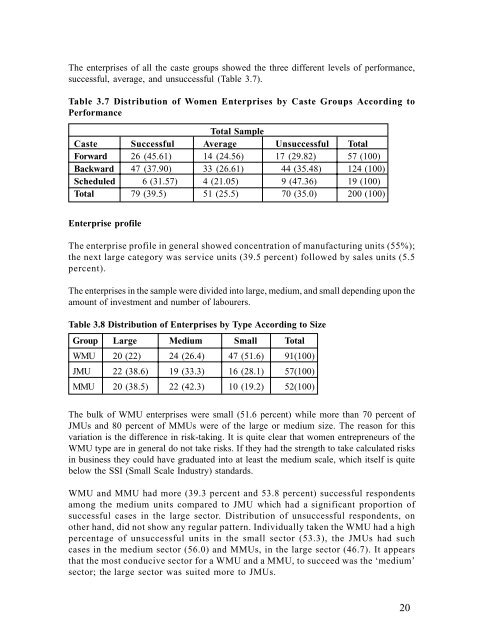Constraints on Women Entrepreneurship Development in Kerala: An ...
Constraints on Women Entrepreneurship Development in Kerala: An ...
Constraints on Women Entrepreneurship Development in Kerala: An ...
You also want an ePaper? Increase the reach of your titles
YUMPU automatically turns print PDFs into web optimized ePapers that Google loves.
The enterprises of all the caste groups showed the three different levels of performance,<br />
successful, average, and unsuccessful (Table 3.7).<br />
Table 3.7 Distributi<strong>on</strong> of <strong>Women</strong> Enterprises by Caste Groups Accord<strong>in</strong>g to<br />
Performance<br />
Total Sample<br />
Caste Successful Average Unsuccessful Total<br />
Forward 26 (45.61) 14 (24.56) 17 (29.82) 57 (100)<br />
Backward 47 (37.90) 33 (26.61) 44 (35.48) 124 (100)<br />
Scheduled 6 (31.57) 4 (21.05) 9 (47.36) 19 (100)<br />
Total 79 (39.5) 51 (25.5) 70 (35.0) 200 (100)<br />
Enterprise profile<br />
The enterprise profile <strong>in</strong> general showed c<strong>on</strong>centrati<strong>on</strong> of manufactur<strong>in</strong>g units (55%);<br />
the next large category was service units (39.5 percent) followed by sales units (5.5<br />
percent).<br />
The enterprises <strong>in</strong> the sample were divided <strong>in</strong>to large, medium, and small depend<strong>in</strong>g up<strong>on</strong> the<br />
amount of <strong>in</strong>vestment and number of labourers.<br />
Table 3.8 Distributi<strong>on</strong> of Enterprises by Type Accord<strong>in</strong>g to Size<br />
Group Large Medium Small Total<br />
WMU 20 (22) 24 (26.4) 47 (51.6) 91(100)<br />
JMU 22 (38.6) 19 (33.3) 16 (28.1) 57(100)<br />
MMU 20 (38.5) 22 (42.3) 10 (19.2) 52(100)<br />
The bulk of WMU enterprises were small (51.6 percent) while more than 70 percent of<br />
JMUs and 80 percent of MMUs were of the large or medium size. The reas<strong>on</strong> for this<br />
variati<strong>on</strong> is the difference <strong>in</strong> risk-tak<strong>in</strong>g. It is quite clear that women entrepreneurs of the<br />
WMU type are <strong>in</strong> general do not take risks. If they had the strength to take calculated risks<br />
<strong>in</strong> bus<strong>in</strong>ess they could have graduated <strong>in</strong>to at least the medium scale, which itself is quite<br />
below the SSI (Small Scale Industry) standards.<br />
WMU and MMU had more (39.3 percent and 53.8 percent) successful resp<strong>on</strong>dents<br />
am<strong>on</strong>g the medium units compared to JMU which had a significant proporti<strong>on</strong> of<br />
successful cases <strong>in</strong> the large sector. Distributi<strong>on</strong> of unsuccessful resp<strong>on</strong>dents, <strong>on</strong><br />
other hand, did not show any regular pattern. Individually taken the WMU had a high<br />
percentage of unsuccessful units <strong>in</strong> the small sector (53.3), the JMUs had such<br />
cases <strong>in</strong> the medium sector (56.0) and MMUs, <strong>in</strong> the large sector (46.7). It appears<br />
that the most c<strong>on</strong>ducive sector for a WMU and a MMU, to succeed was the ‘medium’<br />
sector; the large sector was suited more to JMUs.<br />
20










